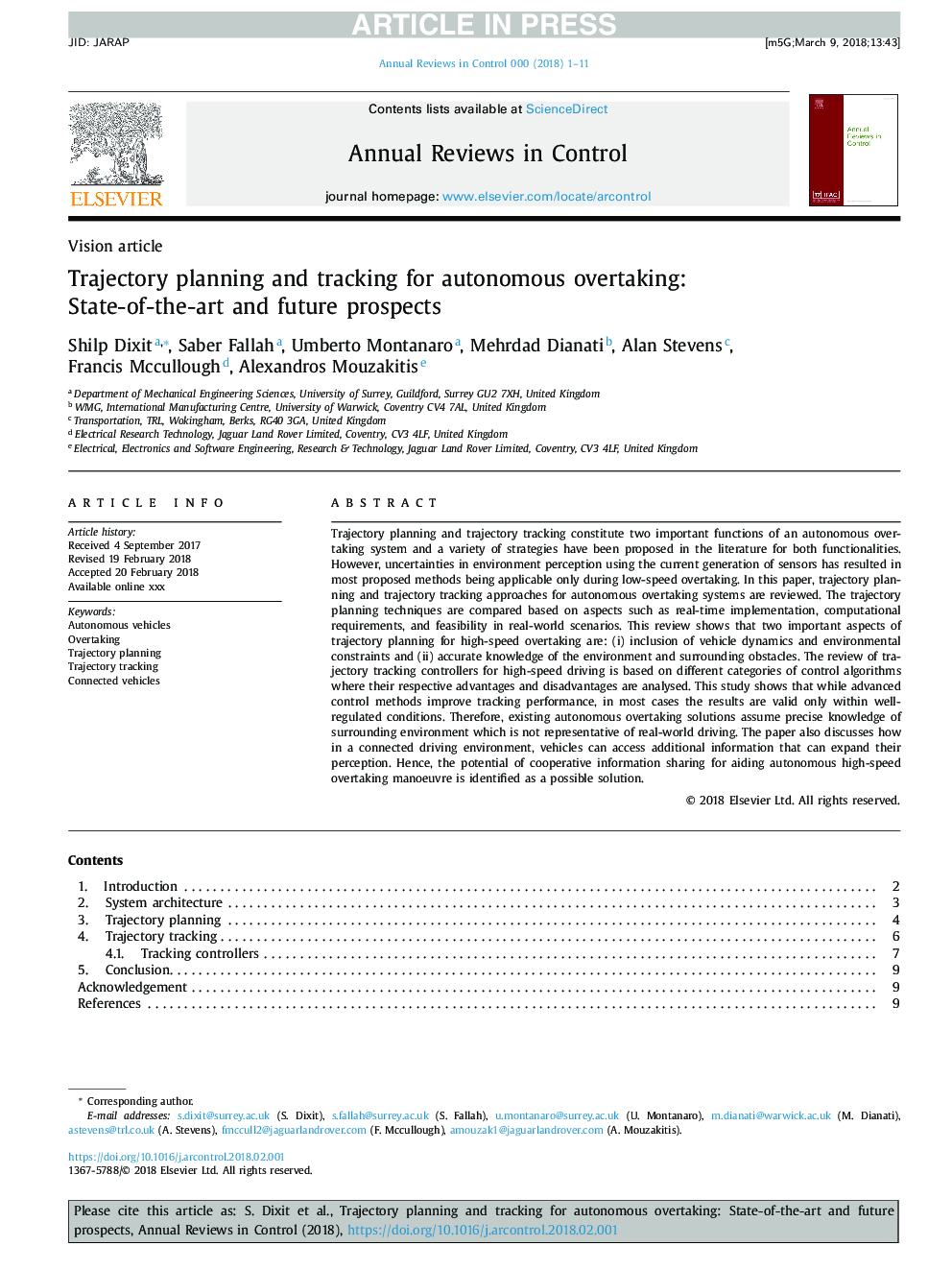| کد مقاله | کد نشریه | سال انتشار | مقاله انگلیسی | نسخه تمام متن |
|---|---|---|---|---|
| 7107684 | 1460585 | 2018 | 11 صفحه PDF | دانلود رایگان |
عنوان انگلیسی مقاله ISI
Trajectory planning and tracking for autonomous overtaking: State-of-the-art and future prospects
ترجمه فارسی عنوان
برنامه ریزی مسیریابی و ردیابی برای اتمام مستقل: چشم انداز پیشرفته و آینده
دانلود مقاله + سفارش ترجمه
دانلود مقاله ISI انگلیسی
رایگان برای ایرانیان
کلمات کلیدی
وسایل نقلیه مستقل، توفان، برنامه ریزی مسیر پیگیری مسیر وسایل نقلیه متصل،
ترجمه چکیده
برنامه ریزی مسیریابی و ردیابی مسیر، دو توابع مهم یک سیستم اتمسفر مستقل است و انواع مختلف استراتژی ها در ادبیات برای هر دو ویژگی ارائه شده است. با این حال، عدم اطمینان در ادراک محیط با استفاده از نسل فعلی سنسور باعث شده است که اکثر روشهای پیشنهادی تنها در هنگام کم شدن سرعت در حال اجرا باشند. در این مقاله، برنامه ریزی مسیریابی و رویکرد ردیابی مسیر برای سیستم های اتمسفر مستقل بررسی شده است. تکنیک های برنامه ریزی مسیریابی بر مبنای جنبه هایی مانند پیاده سازی زمان واقعی، نیازهای محاسباتی و امکان سنجی در سناریوهای واقعی واقعی مقایسه می شود. این بررسی نشان می دهد که دو جنبه مهم برنامه ریزی مسیریابی برای سرعت بالای هلی کوپتر عبارتند از: (1) پویایی خودرو و محدودیت های محیطی و (2) آگاهی دقیق از محیط زیست و موانع اطراف آن. بررسی کنترل ردیابی مسیرهای رانندگی با سرعت بالا مبتنی بر دسته های مختلف الگوریتم های کنترل است که مزایا و معایب آنها مورد تحلیل قرار گرفته است. این مطالعه نشان می دهد که در حالی که روش های پیشرفته کنترل عملکرد ردیابی را بهبود می بخشد، در اغلب موارد نتایج فقط در شرایط خوب تنظیم می شود. بنابراین، راه حل های اتمسفر موجود در حال حاضر دانش دقیق محیط اطراف را در نظر می گیرند که نمایندگی رانندگی در دنیای واقعی نیست. این مقاله همچنین در مورد اینکه چگونه در محیط رانندگی متصل، وسایل نقلیه می توانند به اطلاعات اضافی دسترسی پیدا کنند که می توانند درک خود را افزایش دهند، بحث می شود. از این رو، پتانسیل به اشتراک گذاری اطلاعات تعاونی برای کمک به مانور اتوبوس با سرعت بالا به عنوان یک راه حل ممکن است شناسایی شود.
موضوعات مرتبط
مهندسی و علوم پایه
سایر رشته های مهندسی
کنترل و سیستم های مهندسی
چکیده انگلیسی
Trajectory planning and trajectory tracking constitute two important functions of an autonomous overtaking system and a variety of strategies have been proposed in the literature for both functionalities. However, uncertainties in environment perception using the current generation of sensors has resulted in most proposed methods being applicable only during low-speed overtaking. In this paper, trajectory planning and trajectory tracking approaches for autonomous overtaking systems are reviewed. The trajectory planning techniques are compared based on aspects such as real-time implementation, computational requirements, and feasibility in real-world scenarios. This review shows that two important aspects of trajectory planning for high-speed overtaking are: (i) inclusion of vehicle dynamics and environmental constraints and (ii) accurate knowledge of the environment and surrounding obstacles. The review of trajectory tracking controllers for high-speed driving is based on different categories of control algorithms where their respective advantages and disadvantages are analysed. This study shows that while advanced control methods improve tracking performance, in most cases the results are valid only within well-regulated conditions. Therefore, existing autonomous overtaking solutions assume precise knowledge of surrounding environment which is not representative of real-world driving. The paper also discusses how in a connected driving environment, vehicles can access additional information that can expand their perception. Hence, the potential of cooperative information sharing for aiding autonomous high-speed overtaking manoeuvre is identified as a possible solution.
ناشر
Database: Elsevier - ScienceDirect (ساینس دایرکت)
Journal: Annual Reviews in Control - Volume 45, 2018, Pages 76-86
Journal: Annual Reviews in Control - Volume 45, 2018, Pages 76-86
نویسندگان
Shilp Dixit, Saber Fallah, Umberto Montanaro, Mehrdad Dianati, Alan Stevens, Francis Mccullough, Alexandros Mouzakitis,
